Magnet
A magnet is a substance or object, or material that gives rise to the magnetic field. Magnets are often in Motors and other applications to convert electrical energy into mechanical energy. Magnets can attract or repel other magnets depending on the polarity. The magnet field produced by a magnet is invisible but an essential property of a magnet used in various applications.
A magnet can easily attract metal pieces, such as iron. Materials are categorized based on the ability to be strongly or weakly attracted by a magnet. Here we will discuss types of magnets, shapes of magnets, magnetic materials, applications of the magnet, etc.
Let’s start.
Types of Magnet

The magnets are categorized into three types, which are listed below:
- Temporary Magnets
- Permanent Magnets
- Electromagnets
Temporary Magnets
Temporary magnets are the magnets that retain their magnetic properties until the presence of the nearby magnetic field. The magnetic field created by temporary magnets depends on the magnetic properties of nearby magnets. However, it loses its magnetic properties as soon as the nearby field disappears.
It means that temporary magnets behave like permanent magnets only in the presence of the external magnetic field. The examples include iron, paperclips, etc.
Advantages
- It can be easily magnetized with the application of an external magnetic field.
- The magnetization property helps in the separation of metals and non-metals.
- Do not require any field winding.
- Low cost
Disadvantages
- Low corrosion resistance
- After a certain temperature, magnetism starts decreasing.
Permanent Magnets
A permanent magnet creates its magnetic field. Such magnets retain the magnetic properties for a longer duration. It can even work for a few years if kept in good working conditions. The materials, such as iron, ceramic, and cobalt, can create permanent magnets.
Permanent magnets are also used to provide a magnetic field to metal pieces, such as iron and cobalt, called temporary magnets.
Advantages
- It has its magnetic field.
- It does not require any power supply.
Disadvantages
- Magnetic properties cannot be increased or decreased. It has a fixed magnetic field.
- A large armature current can affect the magnetizing property of permanent magnets.
Let’s discuss the differences between temporary magnets and permanent magnets. It is listed in the below table:
| Category | Temporary Magnet | Permanent Magnet |
|---|---|---|
| Magnetic properties | Remains in the presence of the external magnetic field. | The magnetic properties of such magnets stay for longer durations. |
| Materials made of | Soft Materials | Hard Materials |
| Own Magnetic field | No | Yes |
| Examples | Iron, Nickel, etc. | Steel, etc. |
Electromagnets
Electromagnets are the magnets like solenoids created with insulating copper wire, core, and the power supply. Electromagnet’s magnetic property can be controlled by switching ON/OFF the power supply or controlling the current through the coil.
The common example of electromagnets includes solenoid, as shown below:
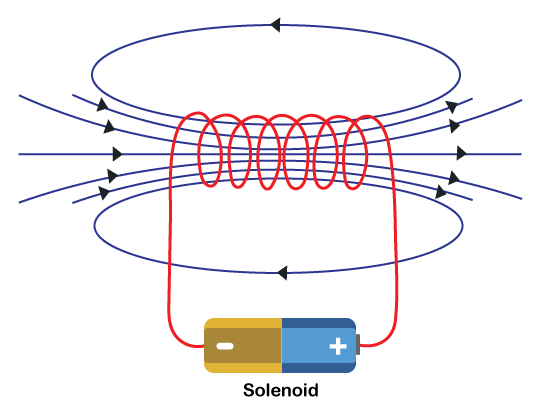
The factors, such as coil material, current, and several turns around the coil, affect the electromagnet’s strength.
Advantages
- The magnetic property of electromagnets can be controlled by allowing or blocking the electric current passing through the coil.
- Simple construction
- Very less pollution
- Compatible with both DC and AC voltage
- The parts of an electromagnet can be easily replaced.
- Polarity can be reversed.
Disadvantages
- It needs a continuous power supply for bet working.
- It heats up quickly.
Let’s discuss the differences between permanent magnets and electromagnets
| Category | Electromagnet | Permanent Magnet |
|---|---|---|
| Magnetic properties | Remains in the presence of an external power supply. | The magnetic properties of such magnets stay for longer durations. |
| Materials made of | Soft Materials | Hard Materials |
| Poles | Poles of an electromagnet can be reversed. | Poles are fixed and cannot be reversed. |
| Magnetic field strength | It can be changed. | It cannot be changed. |
| Examples | Solenoid, etc. | Steel, etc. |
Shapes of Magnets
Magnets come in various shapes with different applications. We can also shape a magnet as per our requirements. Hence, the shapes of a magnet are not limited to a few. Here, we will also discuss the most common shapes of magnets used for different applications.
The different shapes of the magnet are given below:
- Bar Magnets
- Ring Magnets
- Disc Shape magnets
- Horseshoe magnets
- Button Magnets
- Rod Magnets
- Sphere Magnets
- Magnets Rolls
Let’s discuss the above shapes of magnets in detail.
Bar Magnets
Bar magnets are the most used permanent magnets. It has three dimensions called length, breadth, and height. The magnetic property of bar magnets can be in the below form:
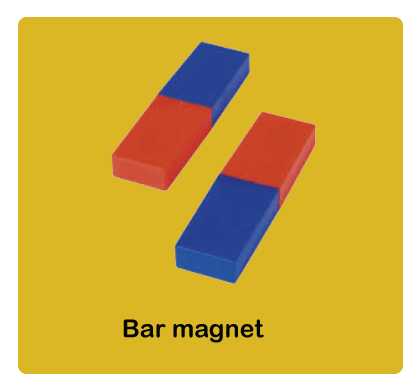
A bar magnet is generally made of ferromagnetic materials, such as iron and steel. It is in the shape of a rectangular bar with the north and South Pole. A freely suspended bar magnet always gets aligned to the Earth’s north magnetic pole.
Bar magnet’s applications include picking small objects (nail, screw, etc.), chemical stirring rods, and refrigerator magnets.
Ring Magnets
The ring magnets can easily work with other shapes, such as rods and tubes. The north and south poles of ring magnets can be divided into various segments. For example, a ring magnet can be divided into four numbers of segments.
The ring magnet looks like the image shown below:
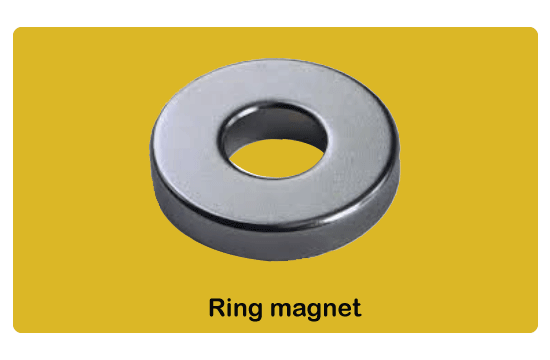
Ring magnets have a flat circular shape with a hole in the center. The hollow center allows the ring magnets to easily slide on the objects like a rod, etc.
Disc Shape magnets
The disc magnet is in the shape of a disc with a flat surface and large poles area. Due to its area, it is considered as effective and strong magnets. The disc magnet looks like the image shown below:
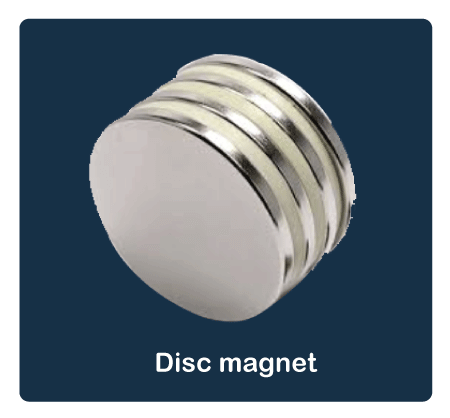
The applications include home decorations and fashion accessories.
Horseshoe magnets
A horseshoe magnet is U shaped magnet. It looks like the image shown below:
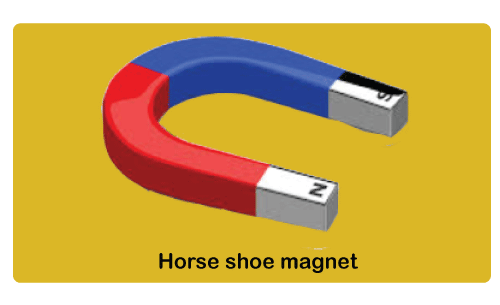
The horseshoe magnet’s magnetic poles are present at the ends of the magnet, as shown above. The two poles generate a strong magnetic field due to the small distance in between. It can also in the form of a C-shape magnet.
Horseshoe magnets are generally the permanent type of magnets. But, an electromagnet can also be created in the shape of a horseshoe magnet. Sometimes, a bar magnet is also modified to create a horseshoe magnet.
Button Magnets
Button magnets are the type of circular magnets, but with no hollow part. The applications of button magnets include craft projects, holding purposes, etc.
It is used in industrial applications and home décor products.
The button magnet looks like the image shown below:
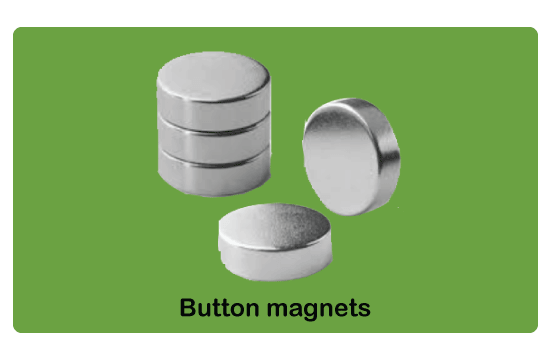
Rod Magnets
Rod magnets are versatile and strong magnets whose length is greater than their diameter. It comes in different sizes and heights. The rod magnets are similar to the cylindrical-shaped magnets.
It is shown in the below image:
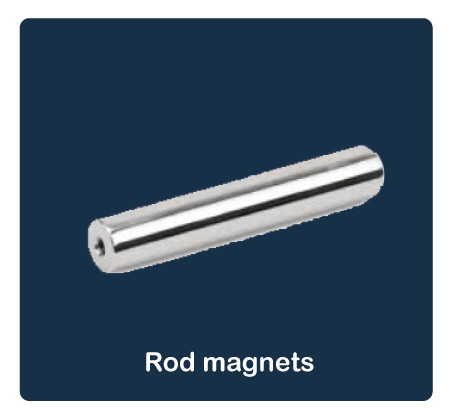
The thickness of such magnets is created to optimize its maximum efficiency. The applications of rod magnets include magnetic grills, etc.
Sphere Magnets
The sphere is spherical shaped magnet comes in various size and colors. The applications of sphere magnets include their use in electronics, hobbyists, products, etc.
It looks like the image shown below:
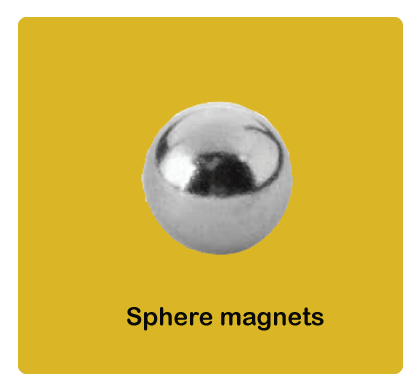
Note: The powerful available earth magnetic material commonly used for rod and sphere magnets is neodymium. It is one of the rarely available magnet materials.
The sphere magnet made with the neodymium material has excellent strength.
Magnets Rolls
Magnet rolls are generally flexible magnetic sheets. We can cut the magnetic sheet into the desired size as per the requirements. We can also cut the sheet with the help of any cutting device, such as a cutter or scissors.
Magnet rolls look like the image shown below:
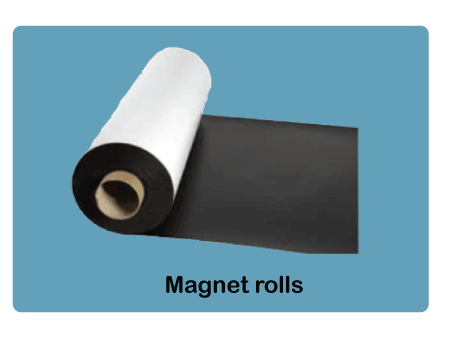
Magnet rolls are available in different thicknesses, sizes, and widths. It is also used for labeling applications, craft items, and planning charts.
Polarity in Magnets
The magnets have two poles. These two poles are named North and South Pole. Polarity in magnets refers to the orientation of the magnets in free space.
We can identify the poles of a magnet in two ways. The first way is to bring a marked magnet in front of a usual magnet. Same polarity poles will repel, and opposite polarity poles will attract. The attraction and repulsion help to determine the polarity of a pole. The marked magnets have North and South poles mentioned on them.
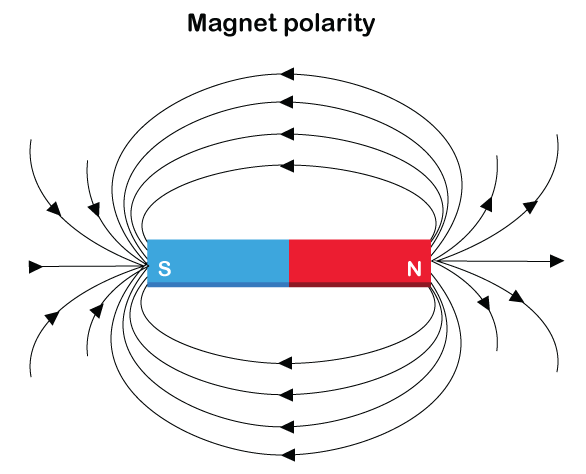
In the case of an electromagnet, we can also reverse the polarity by switching the wire connection.
Magnetic Materials
The magnets refer to an object or material that produces its own magnetic field without any applied magnetic field. But only specific materials produce their own magnetic field. Most of the material relies on external sources to produce the magnetic field. The process is known as magnetism.
Hard and Soft Materials
Let’s first understand the hard and soft materials.
Hard Materials
Hard materials are considered the perfect materials for permanent magnets. Such materials are hard to magnetize (providing magnetism) and demagnetize (removal of magnetism). The generated induction field of hard materials is strong enough to attract the ferromagnetic materials.
Soft Materials
Soft materials are easy to magnetize and demagnetize. These materials suffer from low energy losses. It also has high saturation magnetization.
Magnetic materials are the key components of electrical devices, such as transformers. There are various materials that exhibit different forms of magnetic behavior, which are listed below:
- Ferromagnetic materials
- Paramagnetic materials
- Diamagnetic materials
Let’s discuss the above types of magnetic materials in detail.
Ferromagnetic materials
The ferromagnetic materials under the application of magnetic feel indicate strong magnetism. It means that a ferromagnetic material strongly attracts towards a magnet. These materials can also retain magnetism.
The structure of ferromagnetic materials consists of unpaired electrons, as shown below:
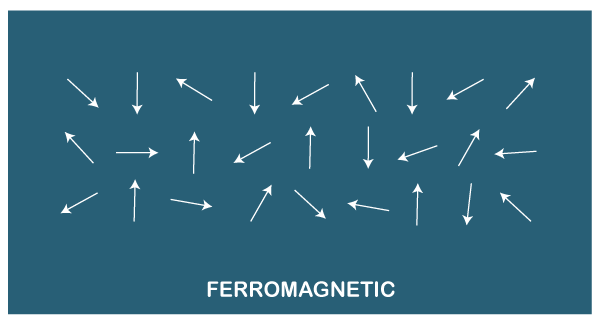
When a magnetic field is applied to such materials, the interaction of electrons will align them in the direction of the applied magnetic field. The magnetization parameters of such materials are always positive. Ferromagnetic materials can also become magnets. Examples include refrigerator magnets, cobalt, etc.
Paramagnetic materials
The paramagnetic materials are weakly attracted to a magnet.
The structure of paramagnetic materials is shown below:
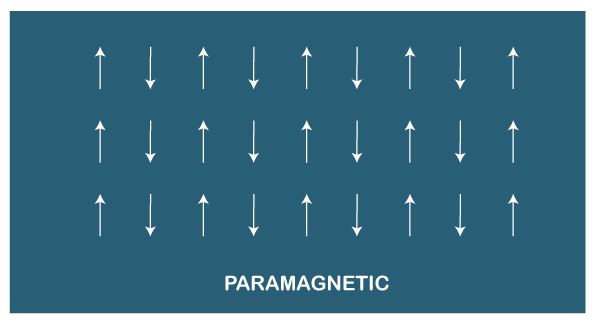
The attraction of these materials is very weak as compared to ferromagnetic materials. Hence, the detection of paramagnetic materials requires sensitive magnets or very strong magnets. Unlike ferromagnetic materials, it cannot retain magnetism after the removal of the applied magnetic field. The examples include aluminum, titanium, etc.
Diamagnetic materials
The structure of diamagnetic materials consists of paired electrons, as shown below:
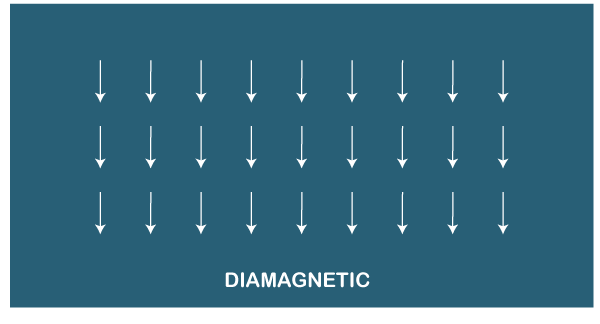
Due to the paired electrons between the atoms, these materials cannot generate their magnetic field. Diamagnetic materials repel or oppose any applied magnetic field. The permeability of such material is less than that of a vacuum. If a substance does not possess any paramagnetic or ferromagnetic, it means that it is diamagnetic. Most of the elements in the periodic table are diamagnetic.
Metamagnetism
A small change in the applied magnetic field can cause a sudden or drastic change in the magnetization property of the materials. It is known as metamagnetism.
Magnetization
Magnetization is defined as the vector field property that reveals the density of dipole moments in the applied magnetic field. For example, paramagnetic substances have weak magnetization, while ferromagnetic substances have strong magnetization. The magnetization doesn’t need to be uniform through the substance or materials. It can vary between different points in a material.
Magnetization can be calculated as:
M = m/V
Where,
m is the dipole moment
V is the volume
M is the magnetization
The above formula is generally used to calculate the dipole moment.
Hence, magnetization is also defined as the magnetic dipole moment per unit volume.
Magnetic Parameters
Magnetic field and Magnetic torque are the two main parameters. Let’s discuss these parameters in detail.
Magnetic field strength
It is denoted by the symbol H. The SI unit of magnetic field strength is Ampere per meter (A/m). Magnetic field strength is also known as magnetic field intensity. The magnetic field strength is the part of a magnetic field that is generated from the external circuitry, which is its source of energy.
Magnetic flux density
Magnetic flux density or magnetic field is a vector field denoted by the symbol B. At a given point, the magnetic field depends on the magnitude and direction of the field. Its SI unit is Tesla or T.
Magnetic moment
The magnetic dipole moment is also known as a magnetic moment. It defines the magnetic properties of a magnet. Its SI unit is Ampere per meter square (A/m^2).
Magnetic susceptibility
The magnetic susceptibility indicates the magnetism of a substance after the application of a magnetic field. It is measured as the ratio of M and H.

Where,
M is the magnetization.
Magnetization is defined as the magnetic moment per unit volume.
H is the magnetic field intensity.
The classification, according to the alignment, is further categorized into:

It depicts that alignment with the magnetic field. The magnetism at this state is called paramagnetism.

It depicts that alignment against the magnetic field. The magnetism at this state is called diamagnetism.
Applications of Magnet
There are different uses of the magnet in various applications, which are listed below:
- Motors
The magnet in motors is used to provide a magnetic field to the circuitry, which helps the armature to rotate. It is based on the principle that converts electrical energy into mechanical energy. The produced energy is further used to rotate the motor. It means that magnets in motors are generally used to create motion. The repulsion and attraction of the poles of a magnet generate the rotational motion of the motor. - Medical Machines
The magnets have good physical properties. The common application of magnets in medicine is its use in MRI (Magnetic Resonance Imaging). Magnets are also used in the motors present inside the surgical devices. - Art materials
Various art materials have magnetic properties that allow them to easily stick on different metal surfaces, such as refrigerators, microwave ovens, etc. Such materials are easy to paint, create, cheap, and easy to carry. - Small science projects
Magnets are widely used in small projects, such as solenoids, etc. - Industrial applications
Magnets in industries are used to separate small iron particles, remove ore from metal, prevent contamination, and use them in transformers. It is also used to separate magnetic and non-magnetic materials. In the case of food industries, magnets are often used to remove metal pieces from food. - Toys
Magnets are a fun component found in toys. But, these magnets are also injurious for small children. - Credit and Debit Cards
The credit and debit card consists of a magnetic chip on it. When these cards are inserted into the card reader machine, the strip encodes the person’s account information. To protect the magnet chip on the magnet, we should keep it away from other magnets. - Speakers
Most of the speakers use a coil and a permanent magnet. Speakers are the devices that convert electrical energy into sound energy. The fiber cone membrane present in the speakers vibrates. The vibration produces sound waves. The force is producing the vibration. The interacting magnetic fields create the vibrations.
A powerful permanent magnet is mounted on the back of the speaker.
The electromagnet coil is suspended inside the permanent magnet. The wire mounted on the coil is a very thin magnet wire. In this way, sounds are created using magnets in speakers. - Microphones
Microphones convert the sound waves into an electrical signal. It works on the principle of electromagnetic induction. The sound waves hit the diaphragm attached to the coil.
It causes the coil to move. Magnets surround the coil. It generates the electric current. Loudspeakers attached to the microphones work in reverse. It reconverts the electrical signal into sound energy. - Seal of home appliances
Most of the home appliances, such as doors and refrigerators, have a magnetic seal. It keeps these devices in a tight seal. - Computers
Magnets are used in various applications because it can store data. The hard drives in computers are used to store the data. It works on the principle-based on electromagnetism. - Magnetic compass
The magnetic needles of the compass align with the components of the Earth’s magnetic field. The magnetic field of the Earth exerts a force on the magnetic needle of a compass. The north end of the compass is directed approximately towards the North Pole of the Earth’s magnetic field and the South Pole towards the South of the Earth’s magnetic field.
